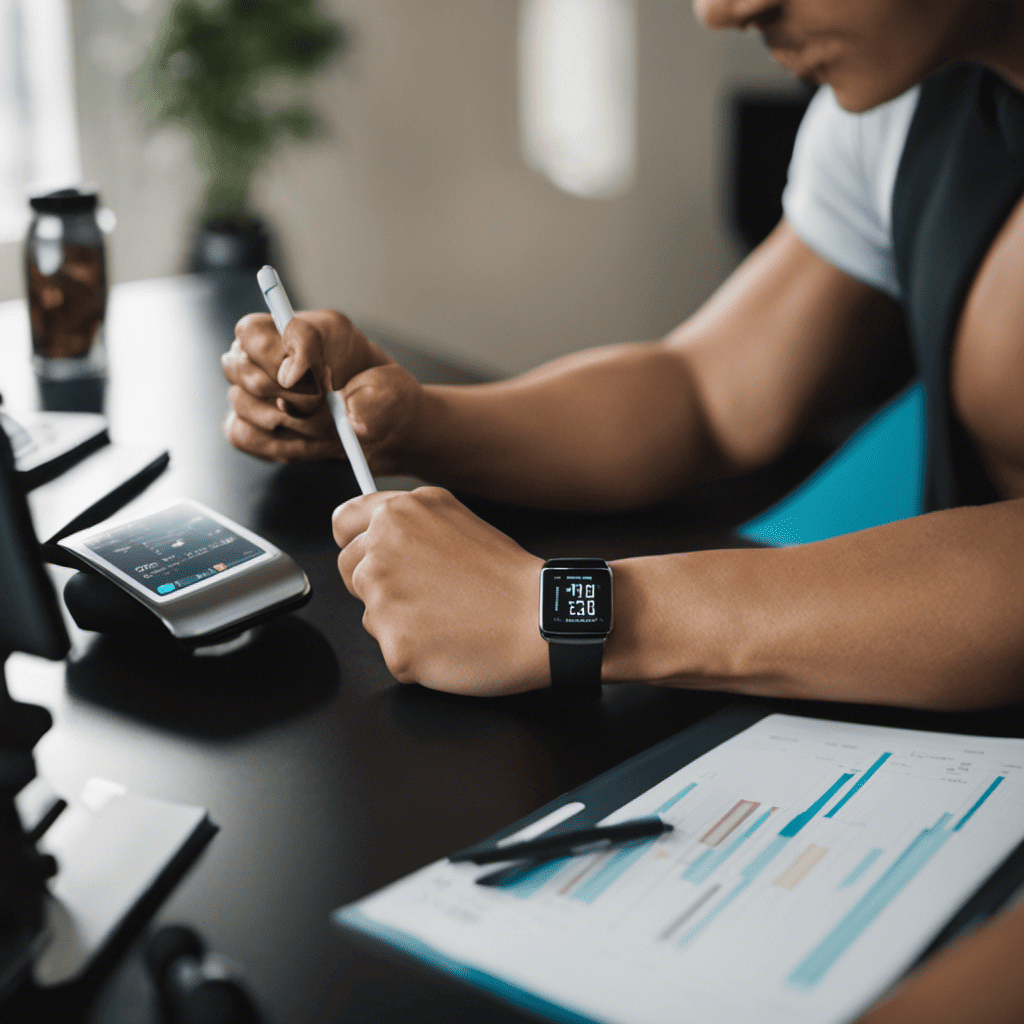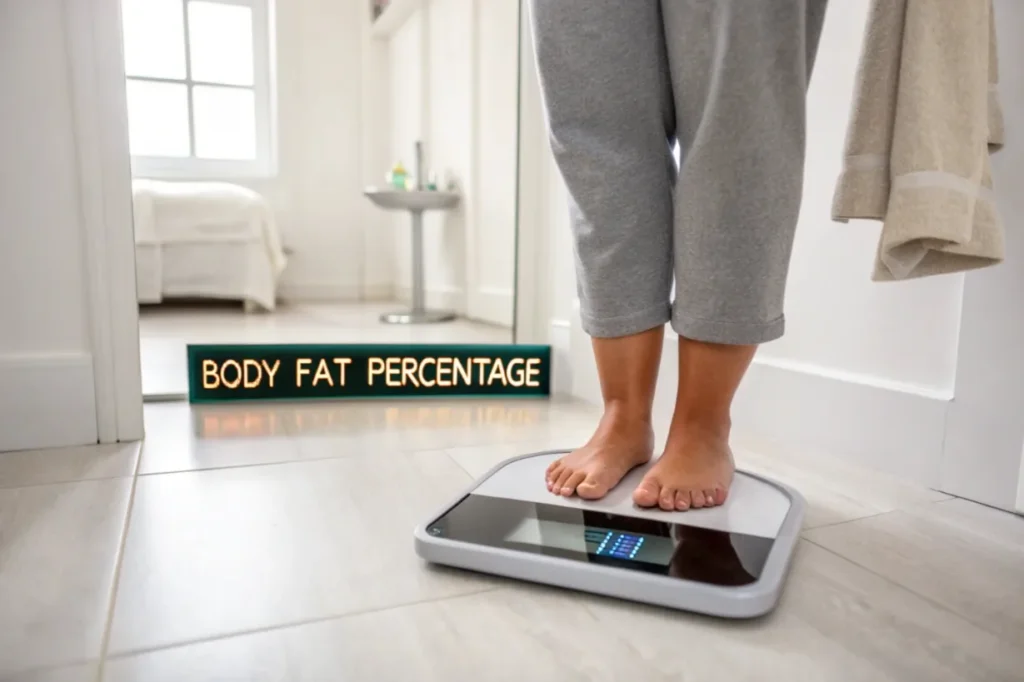Are you curious about how much body fat you have? Understanding your body fat percentage is a crucial step toward achieving optimal health and fitness. With approximately 36% of adults in the United States carrying unhealthy amounts of body fat, it’s important to know where you stand.
In this comprehensive guide, we’ll explore what body fat percentage is, why it matters, and the various methods used to calculate it. We’ll also provide tips on how to achieve a healthy body fat percentage and reduce excess body fat safely and effectively.
Key Takeaways

- Understanding Body Fat Percentage: Learn what body fat percentage is and why it’s important for your health.
- Different Methods of Calculation: Discover various techniques to measure body fat, including skinfold calipers, bioelectrical impedance analysis, DEXA scans, and more.
- Healthy Body Fat Ranges: Find out the recommended body fat percentages based on age and gender.
- Reducing Body Fat: Get practical tips on how to decrease excess body fat through diet, exercise, and lifestyle changes.
- Consulting a Professional: Know when to seek professional guidance for accurate measurements and personalized advice.
Calculate your Body Fat Percentage
Body Fat Percentage Calculator
Calculate your body fat percentage using the US Navy method.
Your Body Fat Percentage:
%
Note: Consult a healthcare professional for a comprehensive evaluation.
What Is Body Fat Percentage?

Body fat percentage refers to the proportion of fat mass compared to your total body mass. It represents how much of your body is composed of fat versus lean tissue such as muscles, bones, and organs. Maintaining a healthy body fat percentage is essential for reducing the risk of chronic diseases and improving overall health.
The Role of Body Fat
Body fat plays several vital roles in the body, including:
- Energy Storage: Fat acts as a reserve of energy that the body can utilize during periods of caloric deficit.
- Insulation and Protection: Fat provides insulation to help regulate body temperature and cushions vital organs.
- Hormone Production: Body fat is involved in the production of essential hormones that regulate metabolic and reproductive functions.
However, excessive body fat, particularly visceral fat (fat stored around the abdominal organs), can increase the risk of health issues such as heart disease, diabetes, and certain cancers.
Why Is Calculating Body Fat Important?
Knowing your body fat percentage offers insights into your overall health status and can help you:
- Assess Health Risks: A high body fat percentage is associated with increased risks of various health conditions.
- Monitor Progress: Tracking changes in body fat can help you evaluate the effectiveness of your fitness and nutrition programs.
- Set Realistic Goals: Understanding your body composition allows you to set and adjust fitness goals appropriately.
Methods of Calculating Body Fat Percentage

There are several methods to estimate body fat percentage, each with its own advantages and limitations. Let’s explore some of the most common techniques.
1. Body Mass Index (BMI)
Body Mass Index (BMI) is a widely used screening tool that calculates an individual’s weight category based on their height and weight.Formula:BMI=Weight (kg)[Height (m)]2BMI=[Height (m)]2Weight (kg)While BMI is easy to calculate, it doesn’t differentiate between fat mass and lean mass, which means it may not accurately reflect body fat percentage, especially in muscular individuals.
2. Skinfold Caliper Measurements
The Skinfold Method uses calipers to measure the thickness of subcutaneous fat at specific sites on the body, such as the triceps, biceps, subscapular (below the shoulder blade), and suprailiac (above the hip bone).
Advantages:
- Affordable and accessible for home or gym use.
- Provides a quick estimate of body fat percentage.
Limitations:
- Accuracy depends on the skill of the person taking the measurements.
- May not be accurate for very lean or higher weight individuals.
3. Bioelectrical Impedance Analysis (BIA)
Bioelectrical Impedance Analysis (BIA) devices send a low-level electrical current through the body to estimate body composition based on the resistance encountered.
Advantages:
- Non-invasive and quick.
- Widely available in scales and handheld devices.
Limitations:
- Hydration levels and recent food intake can affect accuracy.
- Less precise than advanced methods like DEXA scans.
4. Dual-Energy X-ray Absorptiometry (DEXA) Scan
A DEXA Scan is considered one of the most accurate methods for assessing body composition. It uses low-dose X-rays to differentiate among bone mass, lean tissue, and fat tissue.
Advantages:
- Provides detailed information about body fat distribution.
- Highly accurate.
Limitations:
- Expensive and typically requires a visit to a medical facility.
- Not as accessible as other methods.
5. Hydrostatic Weighing
Hydrostatic Weighing, also known as underwater weighing, measures body density by comparing a person’s weight on land to their weight submerged in water.
Advantages:
- Considered a gold standard for accuracy.
Limitations:
- Requires specialized equipment and facilities.
- Can be uncomfortable and impractical for regular monitoring.
Factors Affecting Body Fat Percentage
Several factors can influence an individual’s body fat percentage, including:
- Age: Metabolism slows down with age, and hormonal changes can lead to increased body fat.
- Gender: Women naturally have higher body fat percentages than men due to hormonal differences and reproductive functions.
- Genetics: Genetic predisposition can affect fat distribution and storage.
- Hormonal Functions: Hormones like cortisol, insulin, and sex hormones influence fat accumulation.
- Ethnicity: Ethnic background may impact body composition and fat distribution patterns.
- Lifestyle: Diet, physical activity, stress levels, and sleep patterns play significant roles in body fat percentage.
Healthy Body Fat Percentage Ranges

Maintaining a body fat percentage within recommended ranges is crucial for overall health. Below are general guidelines for healthy body fat percentages based on age and gender.
Healthy Body Fat Percentage for Men
| Age | Healthy Range (%) |
|---|---|
| 18-30 | 8% – 19% |
| 31-50 | 9% – 21% |
| 51-70 | 10% – 22% |
| Over 70 | 11% – 23% |
Healthy Body Fat Percentage for Women
| Age | Healthy Range (%) |
|---|---|
| 18-30 | 21% – 33% |
| 31-50 | 24% – 36% |
| 51-70 | 25% – 37% |
| Over 70 | 26% – 38% |
Note: These ranges can vary depending on the source. It’s important to consult a healthcare professional for personalized recommendations.
Interpreting Your Body Fat Percentage
Understanding what your body fat percentage means helps you assess your health and fitness levels.
- Underfat: Below the recommended range; may indicate nutritional deficiencies or health issues.
- Healthy: Within the recommended range; associated with optimal health and reduced disease risk.
- Overfat: Slightly above the recommended range; may need to make lifestyle adjustments.
- Higher Weight: Significantly above the recommended range; associated with increased health risks.
For personalized interpretation, it’s advisable to consult a healthcare professional or a certified fitness trainer.
Health Risks Associated with Excess Body Fat
Excessive body fat, particularly visceral fat around the abdomen, is linked to several health issues:
- Cardiovascular Disease: Increased risk of heart disease, hypertension, and stroke.
- Type 2 Diabetes: Excess fat can lead to insulin resistance.
- Certain Cancers: Higher risk of cancers like breast, colon, and pancreatic cancer.
- Metabolic Syndrome: A cluster of conditions that increase heart disease risk.
- Joint Problems: Added stress on joints can lead to osteoarthritis.
- Sleep Apnea: Excess fat around the neck can obstruct breathing during sleep.
Tips to Reduce Body Fat Percentage
Achieving a healthy body fat percentage involves a combination of diet, exercise, and lifestyle changes. Here are some effective strategies:
1. Balanced Nutrition
- Caloric Deficit: Consume fewer calories than you burn to promote fat loss.
- Whole Foods: Focus on nutrient-dense foods like fruits, vegetables, lean proteins, and whole grains.
- Healthy Fats: Include sources of healthy fats like avocados, nuts, and olive oil.
- Limit Processed Foods: Reduce intake of sugary beverages, snacks, and fast food.
For personalized meal plans, check out our guide on Meal Planning for Weight Loss.
For more on balanced nutrition, read our article on How to Eat a Balanced and Healthy Diet with Whole Foods.
2. Regular Exercise
- Strength Training: Build muscle mass to increase metabolism and burn more calories at rest.If you’re new to this, check out our guide on Strength Training for Weight Loss for Beginners.
- Cardiovascular Activity: Engage in aerobic exercises like running, cycling, or swimming to burn calories.
- High-Intensity Interval Training (HIIT): Incorporate HIIT workouts for efficient calorie burning.
Discover the Ultimate Guide to HIIT Workouts for effective fat-burning exercises.
3. Stay Hydrated
- Water Intake: Drink adequate water to support metabolism and reduce appetite.
Learn about the Importance of Hydration and how it affects your fitness goals.
4. Adequate Sleep
- Sleep Duration: Aim for 7-9 hours of quality sleep to regulate hunger hormones.
Understanding The Role of Sleep in Fitness and Health can also aid in stress management.
5. Stress Management
- Relaxation Techniques: Practice meditation, yoga, or deep breathing exercises.
- Limit Stressors: Identify and reduce sources of chronic stress.
6. Consistency and Patience
- Lifestyle Change: Focus on sustainable habits rather than quick fixes.
- Monitor Progress: Track your body fat percentage over time and adjust your plan as needed.
Learn How to Track Your Fitness Progress effectively.
Types of Body Fat: Subcutaneous vs. Visceral Fat
Understanding the different types of body fat is important.
Subcutaneous Fat
- Location: Stored directly under the skin.
- Function: Provides insulation and energy storage.
- Considerations: While necessary, excess subcutaneous fat can affect appearance and mobility.
Visceral Fat
- Location: Stored around abdominal organs.
- Function: Too much can interfere with organ function.
- Health Risks: Linked to metabolic diseases and increased health risks.
Learn more about visceral fat and how to target it in our article on How to Lose Belly Fat Overnight.
Frequently Asked Questions (FAQs)
1. How accurate are home body fat scales?
Home body fat scales using BIA can provide a general estimate, but factors like hydration levels can affect accuracy. For precise measurements, professional methods like DEXA scans are recommended.
2. Is BMI a reliable indicator of body fat percentage?
BMI provides a general idea of weight status but doesn’t account for muscle mass. Therefore, athletes or muscular individuals may have a high BMI but low body fat percentage.
3. What is the best method to measure body fat?
DEXA scans are considered the gold standard for accuracy, but accessibility and cost may be limiting factors. Skinfold measurements and BIA devices are practical alternatives for regular monitoring.
4. Can I target fat loss in specific areas?
Spot reduction is a myth. Fat loss occurs throughout the body, and genetics determine where fat is lost first. A combination of diet and full-body exercise is most effective.
5. How often should I measure my body fat percentage?
Monitoring every 4-6 weeks is sufficient to track progress. Measuring too frequently may not show significant changes due to natural fluctuations.
Conclusion
Understanding how body fat is calculated empowers you to take control of your health and fitness journey. By utilizing the various methods available, you can accurately assess your body composition and set realistic goals.
Remember, a healthy body fat percentage contributes not only to improved appearance but also to reduced risks of chronic diseases.For personalized advice and accurate measurements, consider consulting a healthcare professional or certified fitness expert.
At Gear Up to Fit, we’re here to support you every step of the way. Explore our resources on fitness, nutrition, and wellness to help you achieve your health goals.
Disclaimer: Before making any significant changes to your diet or exercise routine, consult with a qualified healthcare professional or certified fitness expert for personalized guidance.
References
- National Institutes of Health
- American Journal of Clinical Nutrition
- National Heart, Lung, and Blood Institute
- World Health Organization
As a veteran fitness technology innovator and the founder of GearUpToFit.com, Alex Papaioannou stands at the intersection of health science and artificial intelligence. With over a decade of specialized experience in digital wellness solutions, he’s transforming how people approach their fitness journey through data-driven methodologies.
